Contemporary Issues in Health and Social Care: Media Influence Report
VerifiedAdded on 2021/06/17
|19
|5261
|307
Report
AI Summary
This report analyzes contemporary issues in health and social care (HSC), emphasizing the crucial role of media in disseminating information and shaping public perception. The report delves into how HSC information reaches the public through various channels, including traditional media and social media platforms. It explores different techniques for information dissemination, such as radio, TV, websites, and social media, and how these methods influence public attitudes, thoughts, and behaviors. The report also examines the ways media can be used to influence public attitudes and behaviors in HSC, including setting public agendas and communicating health policies. Furthermore, it discusses how the public can assess the reliability and validity of media information. The report also investigates patient-reported outcome measures (PROMs) in healthcare, examining the different perspectives on their use and how these perspectives have changed over time. Finally, the report assesses the relevance of the findings to HSC practice locally, particularly in the UK, where PROMs are used to support patient care and inform healthcare decision-making.

Contemporary Issues in Health and Social Care
CONTEMPORARY ISSUES IN HEALTH AND SOCIAL CARE
Class
Professor
University
City
Date
CONTEMPORARY ISSUES IN HEALTH AND SOCIAL CARE
Class
Professor
University
City
Date
Paraphrase This Document
Need a fresh take? Get an instant paraphrase of this document with our AI Paraphraser
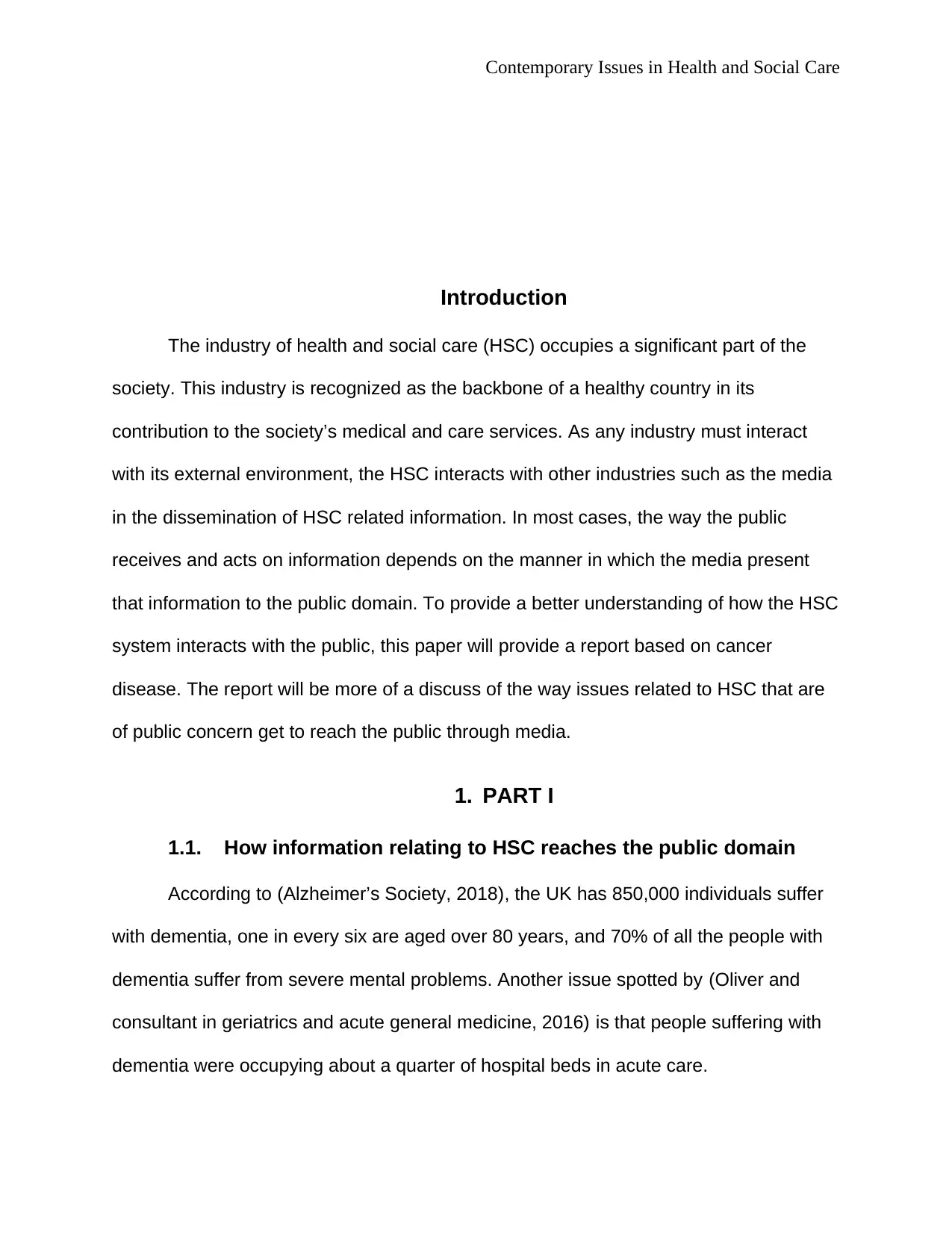
Contemporary Issues in Health and Social Care
Introduction
The industry of health and social care (HSC) occupies a significant part of the
society. This industry is recognized as the backbone of a healthy country in its
contribution to the society’s medical and care services. As any industry must interact
with its external environment, the HSC interacts with other industries such as the media
in the dissemination of HSC related information. In most cases, the way the public
receives and acts on information depends on the manner in which the media present
that information to the public domain. To provide a better understanding of how the HSC
system interacts with the public, this paper will provide a report based on cancer
disease. The report will be more of a discuss of the way issues related to HSC that are
of public concern get to reach the public through media.
1. PART I
1.1. How information relating to HSC reaches the public domain
According to (Alzheimer’s Society, 2018), the UK has 850,000 individuals suffer
with dementia, one in every six are aged over 80 years, and 70% of all the people with
dementia suffer from severe mental problems. Another issue spotted by (Oliver and
consultant in geriatrics and acute general medicine, 2016) is that people suffering with
dementia were occupying about a quarter of hospital beds in acute care.
Introduction
The industry of health and social care (HSC) occupies a significant part of the
society. This industry is recognized as the backbone of a healthy country in its
contribution to the society’s medical and care services. As any industry must interact
with its external environment, the HSC interacts with other industries such as the media
in the dissemination of HSC related information. In most cases, the way the public
receives and acts on information depends on the manner in which the media present
that information to the public domain. To provide a better understanding of how the HSC
system interacts with the public, this paper will provide a report based on cancer
disease. The report will be more of a discuss of the way issues related to HSC that are
of public concern get to reach the public through media.
1. PART I
1.1. How information relating to HSC reaches the public domain
According to (Alzheimer’s Society, 2018), the UK has 850,000 individuals suffer
with dementia, one in every six are aged over 80 years, and 70% of all the people with
dementia suffer from severe mental problems. Another issue spotted by (Oliver and
consultant in geriatrics and acute general medicine, 2016) is that people suffering with
dementia were occupying about a quarter of hospital beds in acute care.
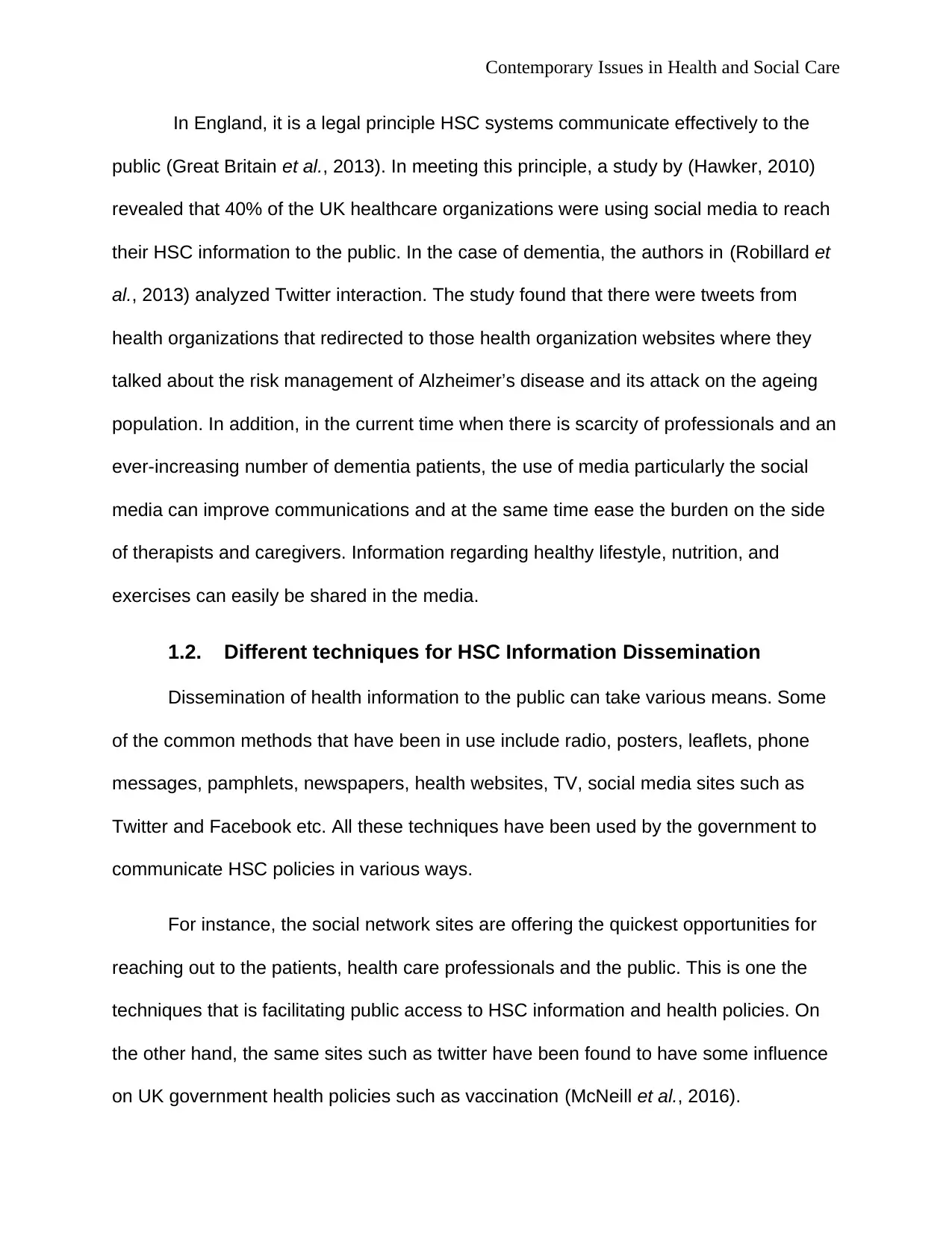
Contemporary Issues in Health and Social Care
In England, it is a legal principle HSC systems communicate effectively to the
public (Great Britain et al., 2013). In meeting this principle, a study by (Hawker, 2010)
revealed that 40% of the UK healthcare organizations were using social media to reach
their HSC information to the public. In the case of dementia, the authors in (Robillard et
al., 2013) analyzed Twitter interaction. The study found that there were tweets from
health organizations that redirected to those health organization websites where they
talked about the risk management of Alzheimer’s disease and its attack on the ageing
population. In addition, in the current time when there is scarcity of professionals and an
ever-increasing number of dementia patients, the use of media particularly the social
media can improve communications and at the same time ease the burden on the side
of therapists and caregivers. Information regarding healthy lifestyle, nutrition, and
exercises can easily be shared in the media.
1.2. Different techniques for HSC Information Dissemination
Dissemination of health information to the public can take various means. Some
of the common methods that have been in use include radio, posters, leaflets, phone
messages, pamphlets, newspapers, health websites, TV, social media sites such as
Twitter and Facebook etc. All these techniques have been used by the government to
communicate HSC policies in various ways.
For instance, the social network sites are offering the quickest opportunities for
reaching out to the patients, health care professionals and the public. This is one the
techniques that is facilitating public access to HSC information and health policies. On
the other hand, the same sites such as twitter have been found to have some influence
on UK government health policies such as vaccination (McNeill et al., 2016).
In England, it is a legal principle HSC systems communicate effectively to the
public (Great Britain et al., 2013). In meeting this principle, a study by (Hawker, 2010)
revealed that 40% of the UK healthcare organizations were using social media to reach
their HSC information to the public. In the case of dementia, the authors in (Robillard et
al., 2013) analyzed Twitter interaction. The study found that there were tweets from
health organizations that redirected to those health organization websites where they
talked about the risk management of Alzheimer’s disease and its attack on the ageing
population. In addition, in the current time when there is scarcity of professionals and an
ever-increasing number of dementia patients, the use of media particularly the social
media can improve communications and at the same time ease the burden on the side
of therapists and caregivers. Information regarding healthy lifestyle, nutrition, and
exercises can easily be shared in the media.
1.2. Different techniques for HSC Information Dissemination
Dissemination of health information to the public can take various means. Some
of the common methods that have been in use include radio, posters, leaflets, phone
messages, pamphlets, newspapers, health websites, TV, social media sites such as
Twitter and Facebook etc. All these techniques have been used by the government to
communicate HSC policies in various ways.
For instance, the social network sites are offering the quickest opportunities for
reaching out to the patients, health care professionals and the public. This is one the
techniques that is facilitating public access to HSC information and health policies. On
the other hand, the same sites such as twitter have been found to have some influence
on UK government health policies such as vaccination (McNeill et al., 2016).
⊘ This is a preview!⊘
Do you want full access?
Subscribe today to unlock all pages.

Trusted by 1+ million students worldwide
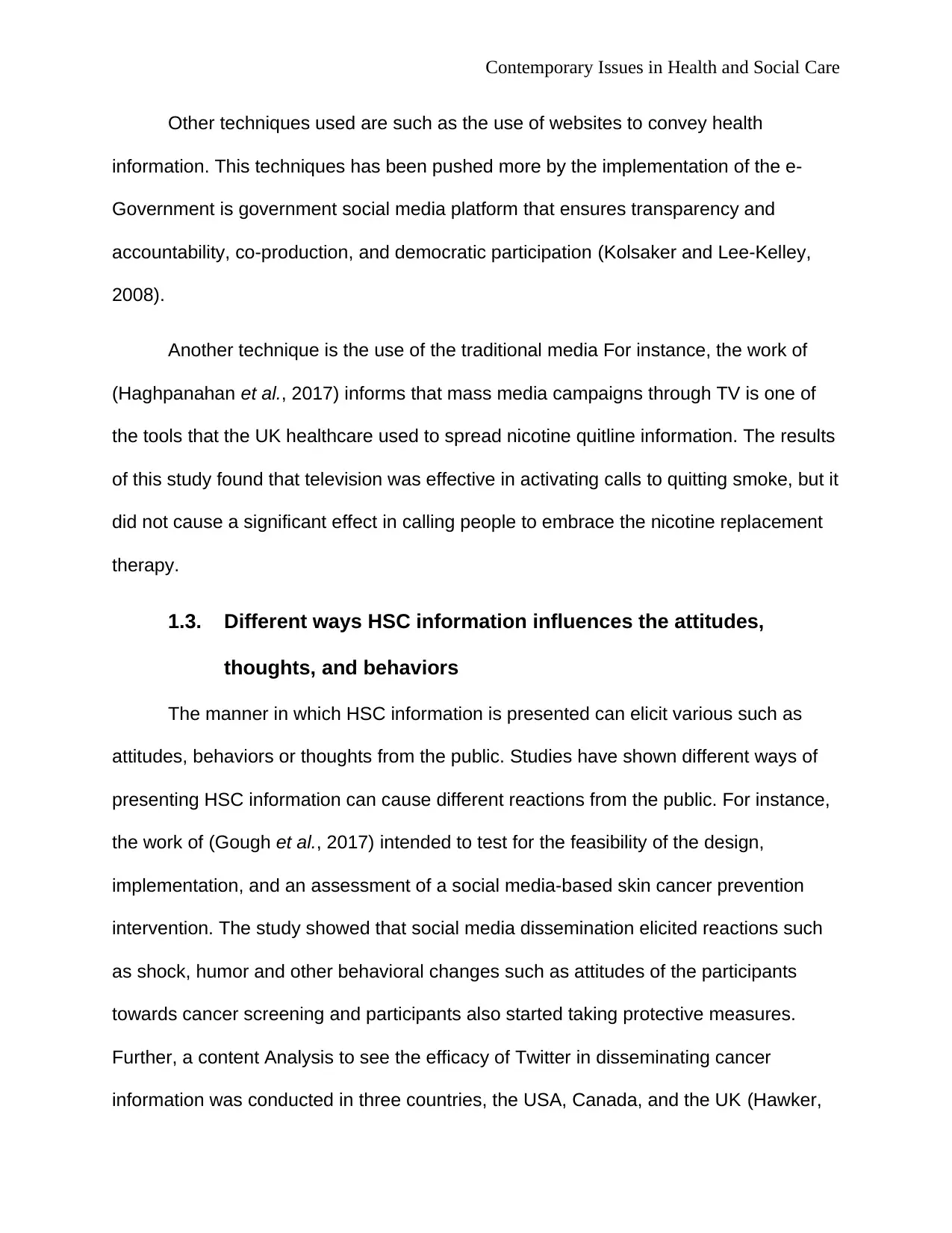
Contemporary Issues in Health and Social Care
Other techniques used are such as the use of websites to convey health
information. This techniques has been pushed more by the implementation of the e-
Government is government social media platform that ensures transparency and
accountability, co-production, and democratic participation (Kolsaker and Lee‐Kelley,
2008).
Another technique is the use of the traditional media For instance, the work of
(Haghpanahan et al., 2017) informs that mass media campaigns through TV is one of
the tools that the UK healthcare used to spread nicotine quitline information. The results
of this study found that television was effective in activating calls to quitting smoke, but it
did not cause a significant effect in calling people to embrace the nicotine replacement
therapy.
1.3. Different ways HSC information influences the attitudes,
thoughts, and behaviors
The manner in which HSC information is presented can elicit various such as
attitudes, behaviors or thoughts from the public. Studies have shown different ways of
presenting HSC information can cause different reactions from the public. For instance,
the work of (Gough et al., 2017) intended to test for the feasibility of the design,
implementation, and an assessment of a social media-based skin cancer prevention
intervention. The study showed that social media dissemination elicited reactions such
as shock, humor and other behavioral changes such as attitudes of the participants
towards cancer screening and participants also started taking protective measures.
Further, a content Analysis to see the efficacy of Twitter in disseminating cancer
information was conducted in three countries, the USA, Canada, and the UK (Hawker,
Other techniques used are such as the use of websites to convey health
information. This techniques has been pushed more by the implementation of the e-
Government is government social media platform that ensures transparency and
accountability, co-production, and democratic participation (Kolsaker and Lee‐Kelley,
2008).
Another technique is the use of the traditional media For instance, the work of
(Haghpanahan et al., 2017) informs that mass media campaigns through TV is one of
the tools that the UK healthcare used to spread nicotine quitline information. The results
of this study found that television was effective in activating calls to quitting smoke, but it
did not cause a significant effect in calling people to embrace the nicotine replacement
therapy.
1.3. Different ways HSC information influences the attitudes,
thoughts, and behaviors
The manner in which HSC information is presented can elicit various such as
attitudes, behaviors or thoughts from the public. Studies have shown different ways of
presenting HSC information can cause different reactions from the public. For instance,
the work of (Gough et al., 2017) intended to test for the feasibility of the design,
implementation, and an assessment of a social media-based skin cancer prevention
intervention. The study showed that social media dissemination elicited reactions such
as shock, humor and other behavioral changes such as attitudes of the participants
towards cancer screening and participants also started taking protective measures.
Further, a content Analysis to see the efficacy of Twitter in disseminating cancer
information was conducted in three countries, the USA, Canada, and the UK (Hawker,
Paraphrase This Document
Need a fresh take? Get an instant paraphrase of this document with our AI Paraphraser
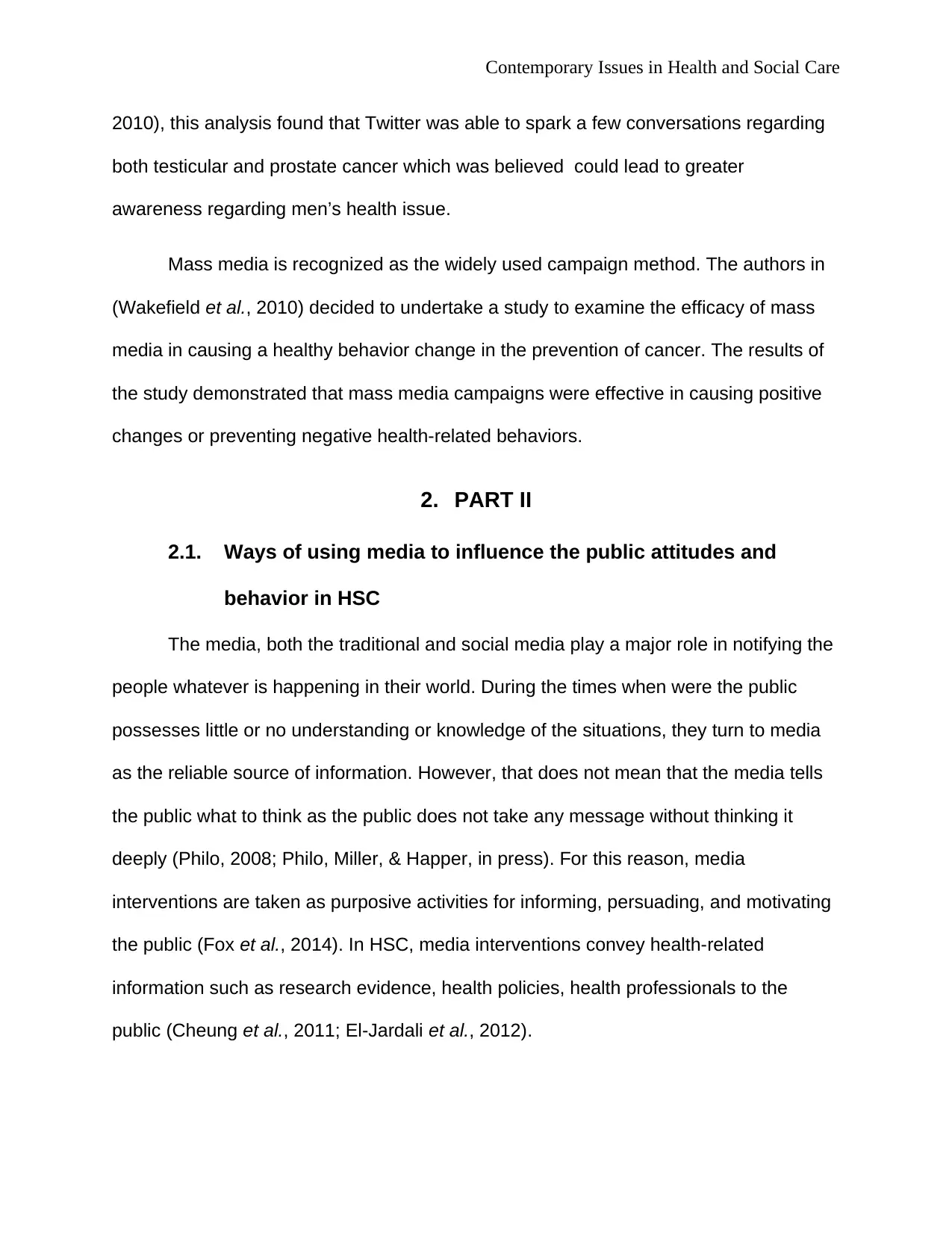
Contemporary Issues in Health and Social Care
2010), this analysis found that Twitter was able to spark a few conversations regarding
both testicular and prostate cancer which was believed could lead to greater
awareness regarding men’s health issue.
Mass media is recognized as the widely used campaign method. The authors in
(Wakefield et al., 2010) decided to undertake a study to examine the efficacy of mass
media in causing a healthy behavior change in the prevention of cancer. The results of
the study demonstrated that mass media campaigns were effective in causing positive
changes or preventing negative health-related behaviors.
2. PART II
2.1. Ways of using media to influence the public attitudes and
behavior in HSC
The media, both the traditional and social media play a major role in notifying the
people whatever is happening in their world. During the times when were the public
possesses little or no understanding or knowledge of the situations, they turn to media
as the reliable source of information. However, that does not mean that the media tells
the public what to think as the public does not take any message without thinking it
deeply (Philo, 2008; Philo, Miller, & Happer, in press). For this reason, media
interventions are taken as purposive activities for informing, persuading, and motivating
the public (Fox et al., 2014). In HSC, media interventions convey health-related
information such as research evidence, health policies, health professionals to the
public (Cheung et al., 2011; El-Jardali et al., 2012).
2010), this analysis found that Twitter was able to spark a few conversations regarding
both testicular and prostate cancer which was believed could lead to greater
awareness regarding men’s health issue.
Mass media is recognized as the widely used campaign method. The authors in
(Wakefield et al., 2010) decided to undertake a study to examine the efficacy of mass
media in causing a healthy behavior change in the prevention of cancer. The results of
the study demonstrated that mass media campaigns were effective in causing positive
changes or preventing negative health-related behaviors.
2. PART II
2.1. Ways of using media to influence the public attitudes and
behavior in HSC
The media, both the traditional and social media play a major role in notifying the
people whatever is happening in their world. During the times when were the public
possesses little or no understanding or knowledge of the situations, they turn to media
as the reliable source of information. However, that does not mean that the media tells
the public what to think as the public does not take any message without thinking it
deeply (Philo, 2008; Philo, Miller, & Happer, in press). For this reason, media
interventions are taken as purposive activities for informing, persuading, and motivating
the public (Fox et al., 2014). In HSC, media interventions convey health-related
information such as research evidence, health policies, health professionals to the
public (Cheung et al., 2011; El-Jardali et al., 2012).

Contemporary Issues in Health and Social Care
Media has also been seen to inspire individual health behaviors such as
decreasing smoking (Wakefield et al., 2010). In government and policies, media has
been seen to set public agendas, communicating health policies such as medical
subsidies and benefits (Lancaster et al., 2011; Silva et al., 2016). Media also influence
public and policymakers by communicating the public views which inform policymakers
the best way to respond (Buse et al., 2012). For example, through media advocacy, the
media creates public awareness which mobilizes decision-makers in health policy
changes (Dorfman and Krasnow, 2014). Social media on its part provide peer support,
extends information on health interventions and informs policymakers (Oxman et al.,
2009; Williams et al., 2014). Social media also acts as a platform for interaction
between an individual and health professionals (Moorhead et al., 2013).
2.2. Way on how the public may assess the media information on
HSC to check its reliability and the validity
In this era where there is much production of information all targeting the public
consumption, the lay consumers must assess the reliability and validity of such
information. The low literate consumer takes an examination of two types of information,
the online information that comes from social media, and the information that comes
from the traditional media. Reliability, accuracy and quality of health information has
been reported as an important feature to the most of Internet consumers. For instance,
the study of (Silver, 2015) showed that internet users are aware that not all information
from the web can be trusted.
A study conducted to analyses how the public assess the validity and reliability
on both types of media information found that the public access information through the
Media has also been seen to inspire individual health behaviors such as
decreasing smoking (Wakefield et al., 2010). In government and policies, media has
been seen to set public agendas, communicating health policies such as medical
subsidies and benefits (Lancaster et al., 2011; Silva et al., 2016). Media also influence
public and policymakers by communicating the public views which inform policymakers
the best way to respond (Buse et al., 2012). For example, through media advocacy, the
media creates public awareness which mobilizes decision-makers in health policy
changes (Dorfman and Krasnow, 2014). Social media on its part provide peer support,
extends information on health interventions and informs policymakers (Oxman et al.,
2009; Williams et al., 2014). Social media also acts as a platform for interaction
between an individual and health professionals (Moorhead et al., 2013).
2.2. Way on how the public may assess the media information on
HSC to check its reliability and the validity
In this era where there is much production of information all targeting the public
consumption, the lay consumers must assess the reliability and validity of such
information. The low literate consumer takes an examination of two types of information,
the online information that comes from social media, and the information that comes
from the traditional media. Reliability, accuracy and quality of health information has
been reported as an important feature to the most of Internet consumers. For instance,
the study of (Silver, 2015) showed that internet users are aware that not all information
from the web can be trusted.
A study conducted to analyses how the public assess the validity and reliability
on both types of media information found that the public access information through the
⊘ This is a preview!⊘
Do you want full access?
Subscribe today to unlock all pages.

Trusted by 1+ million students worldwide
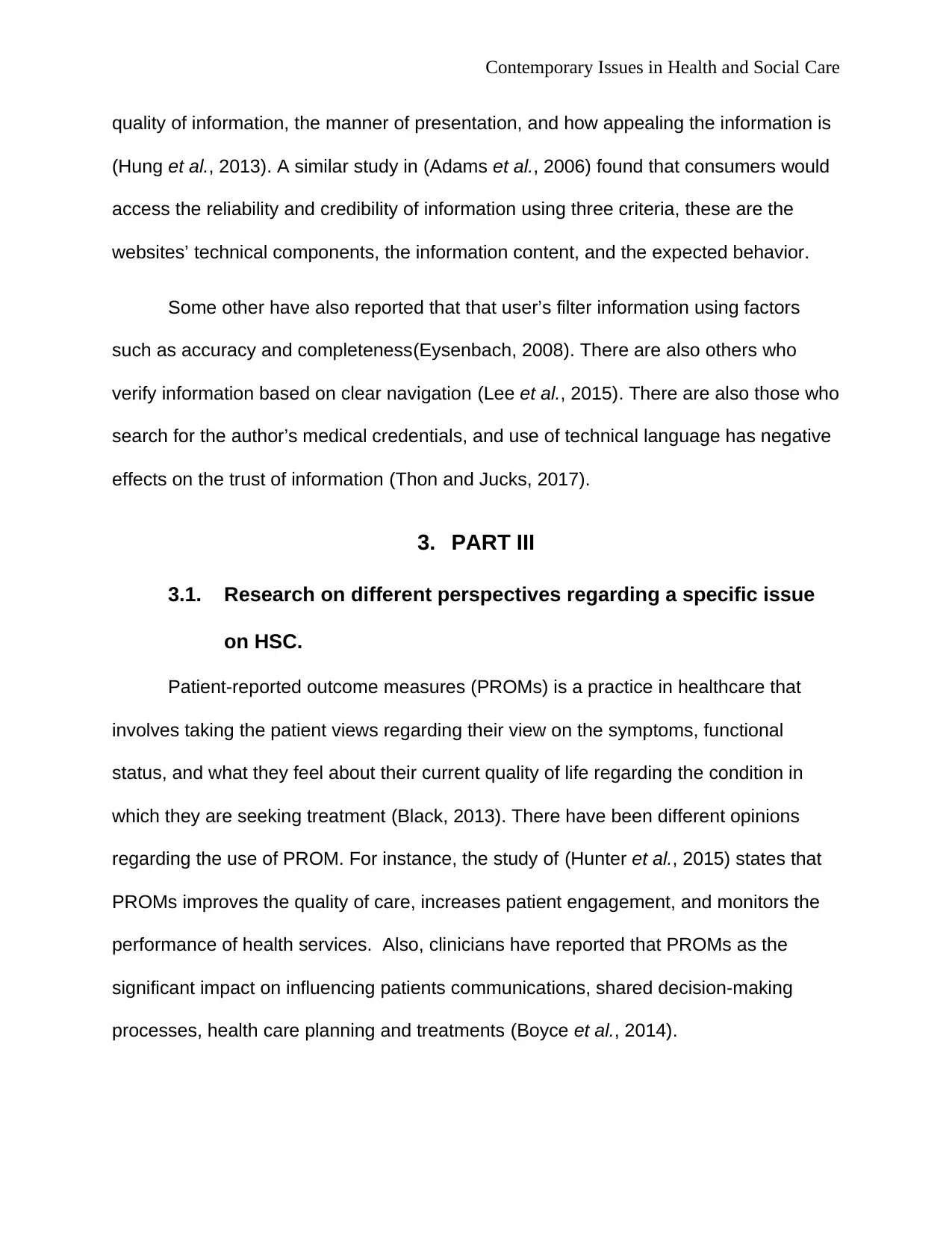
Contemporary Issues in Health and Social Care
quality of information, the manner of presentation, and how appealing the information is
(Hung et al., 2013). A similar study in (Adams et al., 2006) found that consumers would
access the reliability and credibility of information using three criteria, these are the
websites’ technical components, the information content, and the expected behavior.
Some other have also reported that that user’s filter information using factors
such as accuracy and completeness(Eysenbach, 2008). There are also others who
verify information based on clear navigation (Lee et al., 2015). There are also those who
search for the author’s medical credentials, and use of technical language has negative
effects on the trust of information (Thon and Jucks, 2017).
3. PART III
3.1. Research on different perspectives regarding a specific issue
on HSC.
Patient-reported outcome measures (PROMs) is a practice in healthcare that
involves taking the patient views regarding their view on the symptoms, functional
status, and what they feel about their current quality of life regarding the condition in
which they are seeking treatment (Black, 2013). There have been different opinions
regarding the use of PROM. For instance, the study of (Hunter et al., 2015) states that
PROMs improves the quality of care, increases patient engagement, and monitors the
performance of health services. Also, clinicians have reported that PROMs as the
significant impact on influencing patients communications, shared decision-making
processes, health care planning and treatments (Boyce et al., 2014).
quality of information, the manner of presentation, and how appealing the information is
(Hung et al., 2013). A similar study in (Adams et al., 2006) found that consumers would
access the reliability and credibility of information using three criteria, these are the
websites’ technical components, the information content, and the expected behavior.
Some other have also reported that that user’s filter information using factors
such as accuracy and completeness(Eysenbach, 2008). There are also others who
verify information based on clear navigation (Lee et al., 2015). There are also those who
search for the author’s medical credentials, and use of technical language has negative
effects on the trust of information (Thon and Jucks, 2017).
3. PART III
3.1. Research on different perspectives regarding a specific issue
on HSC.
Patient-reported outcome measures (PROMs) is a practice in healthcare that
involves taking the patient views regarding their view on the symptoms, functional
status, and what they feel about their current quality of life regarding the condition in
which they are seeking treatment (Black, 2013). There have been different opinions
regarding the use of PROM. For instance, the study of (Hunter et al., 2015) states that
PROMs improves the quality of care, increases patient engagement, and monitors the
performance of health services. Also, clinicians have reported that PROMs as the
significant impact on influencing patients communications, shared decision-making
processes, health care planning and treatments (Boyce et al., 2014).
Paraphrase This Document
Need a fresh take? Get an instant paraphrase of this document with our AI Paraphraser
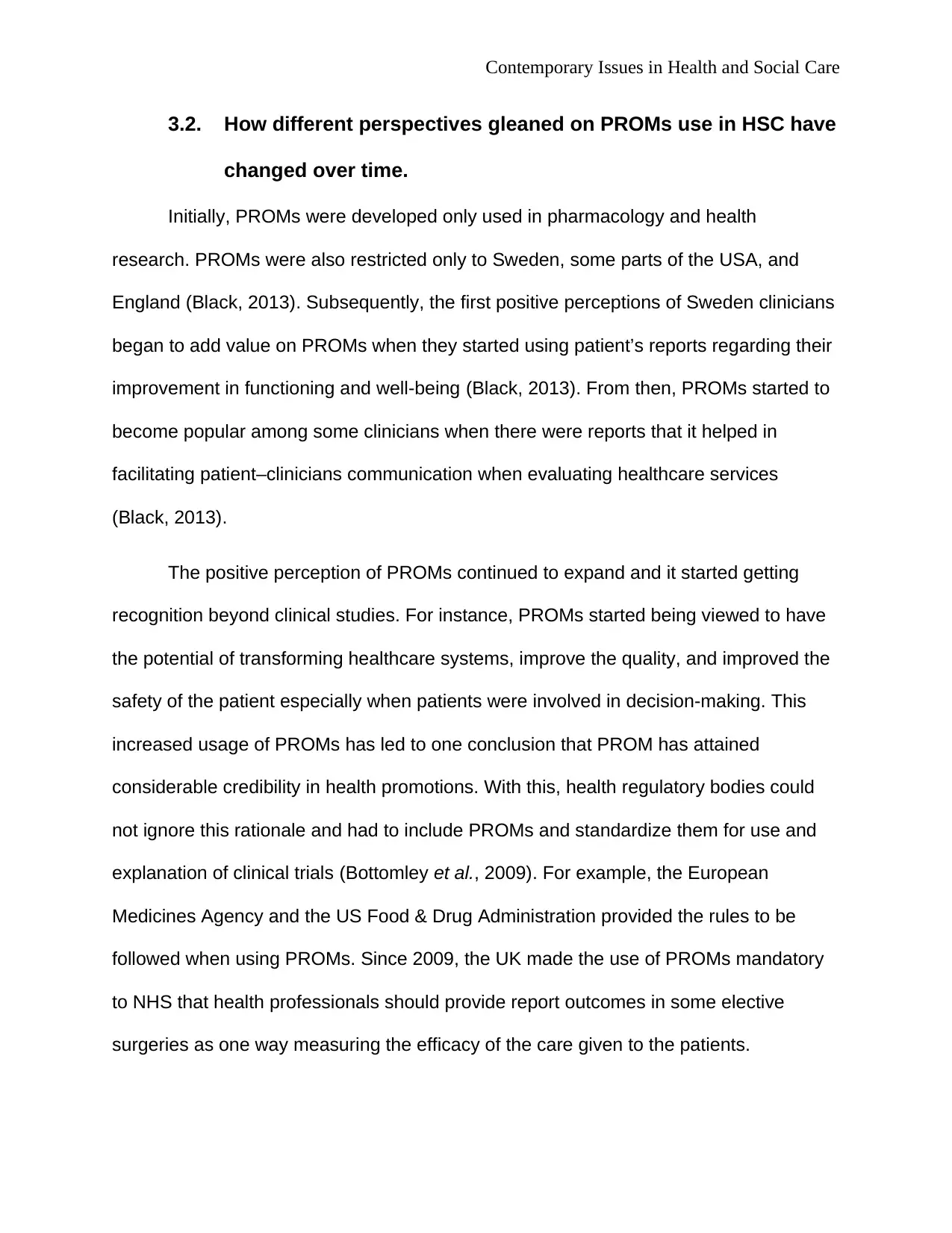
Contemporary Issues in Health and Social Care
3.2. How different perspectives gleaned on PROMs use in HSC have
changed over time.
Initially, PROMs were developed only used in pharmacology and health
research. PROMs were also restricted only to Sweden, some parts of the USA, and
England (Black, 2013). Subsequently, the first positive perceptions of Sweden clinicians
began to add value on PROMs when they started using patient’s reports regarding their
improvement in functioning and well-being (Black, 2013). From then, PROMs started to
become popular among some clinicians when there were reports that it helped in
facilitating patient–clinicians communication when evaluating healthcare services
(Black, 2013).
The positive perception of PROMs continued to expand and it started getting
recognition beyond clinical studies. For instance, PROMs started being viewed to have
the potential of transforming healthcare systems, improve the quality, and improved the
safety of the patient especially when patients were involved in decision-making. This
increased usage of PROMs has led to one conclusion that PROM has attained
considerable credibility in health promotions. With this, health regulatory bodies could
not ignore this rationale and had to include PROMs and standardize them for use and
explanation of clinical trials (Bottomley et al., 2009). For example, the European
Medicines Agency and the US Food & Drug Administration provided the rules to be
followed when using PROMs. Since 2009, the UK made the use of PROMs mandatory
to NHS that health professionals should provide report outcomes in some elective
surgeries as one way measuring the efficacy of the care given to the patients.
3.2. How different perspectives gleaned on PROMs use in HSC have
changed over time.
Initially, PROMs were developed only used in pharmacology and health
research. PROMs were also restricted only to Sweden, some parts of the USA, and
England (Black, 2013). Subsequently, the first positive perceptions of Sweden clinicians
began to add value on PROMs when they started using patient’s reports regarding their
improvement in functioning and well-being (Black, 2013). From then, PROMs started to
become popular among some clinicians when there were reports that it helped in
facilitating patient–clinicians communication when evaluating healthcare services
(Black, 2013).
The positive perception of PROMs continued to expand and it started getting
recognition beyond clinical studies. For instance, PROMs started being viewed to have
the potential of transforming healthcare systems, improve the quality, and improved the
safety of the patient especially when patients were involved in decision-making. This
increased usage of PROMs has led to one conclusion that PROM has attained
considerable credibility in health promotions. With this, health regulatory bodies could
not ignore this rationale and had to include PROMs and standardize them for use and
explanation of clinical trials (Bottomley et al., 2009). For example, the European
Medicines Agency and the US Food & Drug Administration provided the rules to be
followed when using PROMs. Since 2009, the UK made the use of PROMs mandatory
to NHS that health professionals should provide report outcomes in some elective
surgeries as one way measuring the efficacy of the care given to the patients.
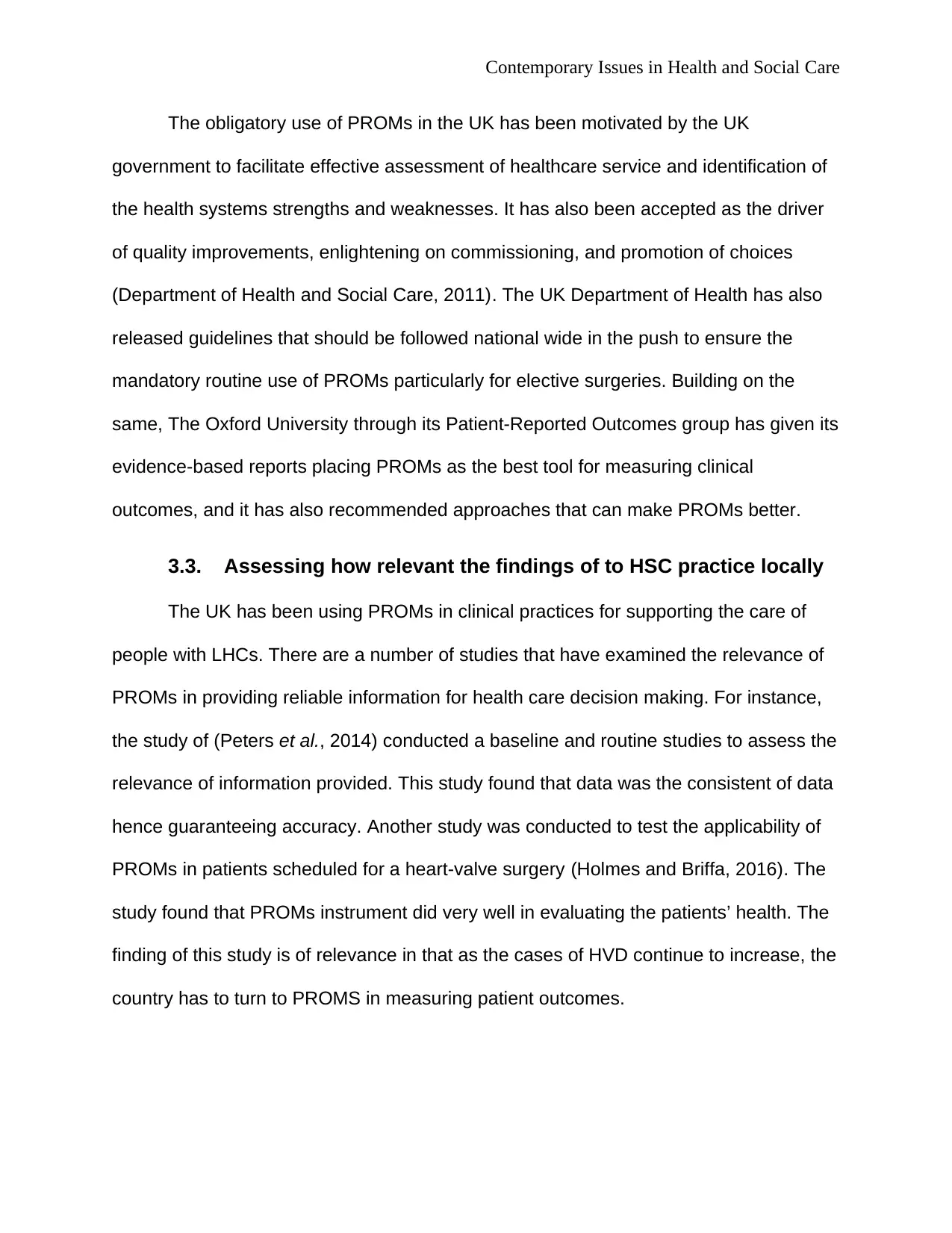
Contemporary Issues in Health and Social Care
The obligatory use of PROMs in the UK has been motivated by the UK
government to facilitate effective assessment of healthcare service and identification of
the health systems strengths and weaknesses. It has also been accepted as the driver
of quality improvements, enlightening on commissioning, and promotion of choices
(Department of Health and Social Care, 2011). The UK Department of Health has also
released guidelines that should be followed national wide in the push to ensure the
mandatory routine use of PROMs particularly for elective surgeries. Building on the
same, The Oxford University through its Patient-Reported Outcomes group has given its
evidence-based reports placing PROMs as the best tool for measuring clinical
outcomes, and it has also recommended approaches that can make PROMs better.
3.3. Assessing how relevant the findings of to HSC practice locally
The UK has been using PROMs in clinical practices for supporting the care of
people with LHCs. There are a number of studies that have examined the relevance of
PROMs in providing reliable information for health care decision making. For instance,
the study of (Peters et al., 2014) conducted a baseline and routine studies to assess the
relevance of information provided. This study found that data was the consistent of data
hence guaranteeing accuracy. Another study was conducted to test the applicability of
PROMs in patients scheduled for a heart-valve surgery (Holmes and Briffa, 2016). The
study found that PROMs instrument did very well in evaluating the patients’ health. The
finding of this study is of relevance in that as the cases of HVD continue to increase, the
country has to turn to PROMS in measuring patient outcomes.
The obligatory use of PROMs in the UK has been motivated by the UK
government to facilitate effective assessment of healthcare service and identification of
the health systems strengths and weaknesses. It has also been accepted as the driver
of quality improvements, enlightening on commissioning, and promotion of choices
(Department of Health and Social Care, 2011). The UK Department of Health has also
released guidelines that should be followed national wide in the push to ensure the
mandatory routine use of PROMs particularly for elective surgeries. Building on the
same, The Oxford University through its Patient-Reported Outcomes group has given its
evidence-based reports placing PROMs as the best tool for measuring clinical
outcomes, and it has also recommended approaches that can make PROMs better.
3.3. Assessing how relevant the findings of to HSC practice locally
The UK has been using PROMs in clinical practices for supporting the care of
people with LHCs. There are a number of studies that have examined the relevance of
PROMs in providing reliable information for health care decision making. For instance,
the study of (Peters et al., 2014) conducted a baseline and routine studies to assess the
relevance of information provided. This study found that data was the consistent of data
hence guaranteeing accuracy. Another study was conducted to test the applicability of
PROMs in patients scheduled for a heart-valve surgery (Holmes and Briffa, 2016). The
study found that PROMs instrument did very well in evaluating the patients’ health. The
finding of this study is of relevance in that as the cases of HVD continue to increase, the
country has to turn to PROMS in measuring patient outcomes.
⊘ This is a preview!⊘
Do you want full access?
Subscribe today to unlock all pages.

Trusted by 1+ million students worldwide
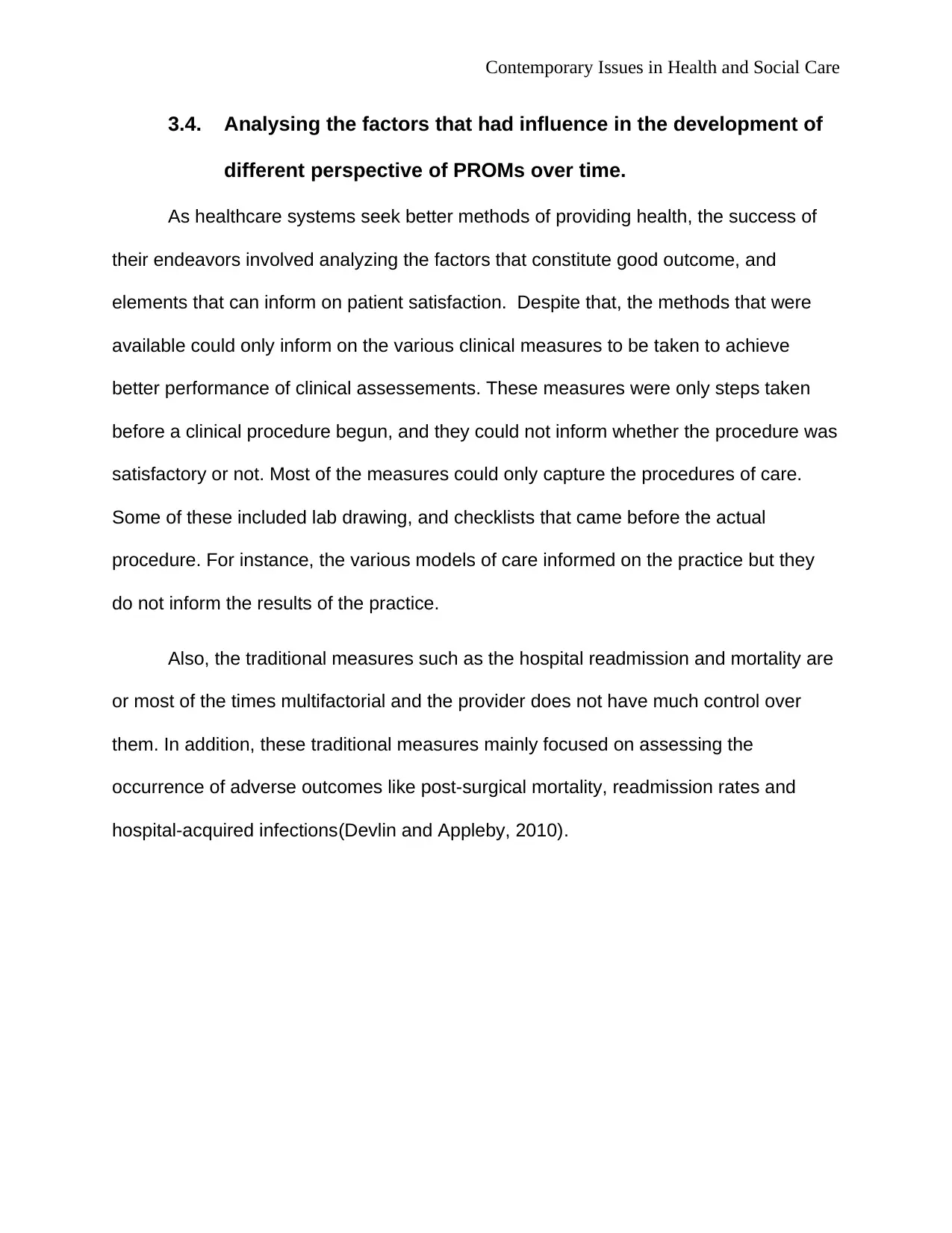
Contemporary Issues in Health and Social Care
3.4. Analysing the factors that had influence in the development of
different perspective of PROMs over time.
As healthcare systems seek better methods of providing health, the success of
their endeavors involved analyzing the factors that constitute good outcome, and
elements that can inform on patient satisfaction. Despite that, the methods that were
available could only inform on the various clinical measures to be taken to achieve
better performance of clinical assessements. These measures were only steps taken
before a clinical procedure begun, and they could not inform whether the procedure was
satisfactory or not. Most of the measures could only capture the procedures of care.
Some of these included lab drawing, and checklists that came before the actual
procedure. For instance, the various models of care informed on the practice but they
do not inform the results of the practice.
Also, the traditional measures such as the hospital readmission and mortality are
or most of the times multifactorial and the provider does not have much control over
them. In addition, these traditional measures mainly focused on assessing the
occurrence of adverse outcomes like post-surgical mortality, readmission rates and
hospital-acquired infections(Devlin and Appleby, 2010).
3.4. Analysing the factors that had influence in the development of
different perspective of PROMs over time.
As healthcare systems seek better methods of providing health, the success of
their endeavors involved analyzing the factors that constitute good outcome, and
elements that can inform on patient satisfaction. Despite that, the methods that were
available could only inform on the various clinical measures to be taken to achieve
better performance of clinical assessements. These measures were only steps taken
before a clinical procedure begun, and they could not inform whether the procedure was
satisfactory or not. Most of the measures could only capture the procedures of care.
Some of these included lab drawing, and checklists that came before the actual
procedure. For instance, the various models of care informed on the practice but they
do not inform the results of the practice.
Also, the traditional measures such as the hospital readmission and mortality are
or most of the times multifactorial and the provider does not have much control over
them. In addition, these traditional measures mainly focused on assessing the
occurrence of adverse outcomes like post-surgical mortality, readmission rates and
hospital-acquired infections(Devlin and Appleby, 2010).
Paraphrase This Document
Need a fresh take? Get an instant paraphrase of this document with our AI Paraphraser
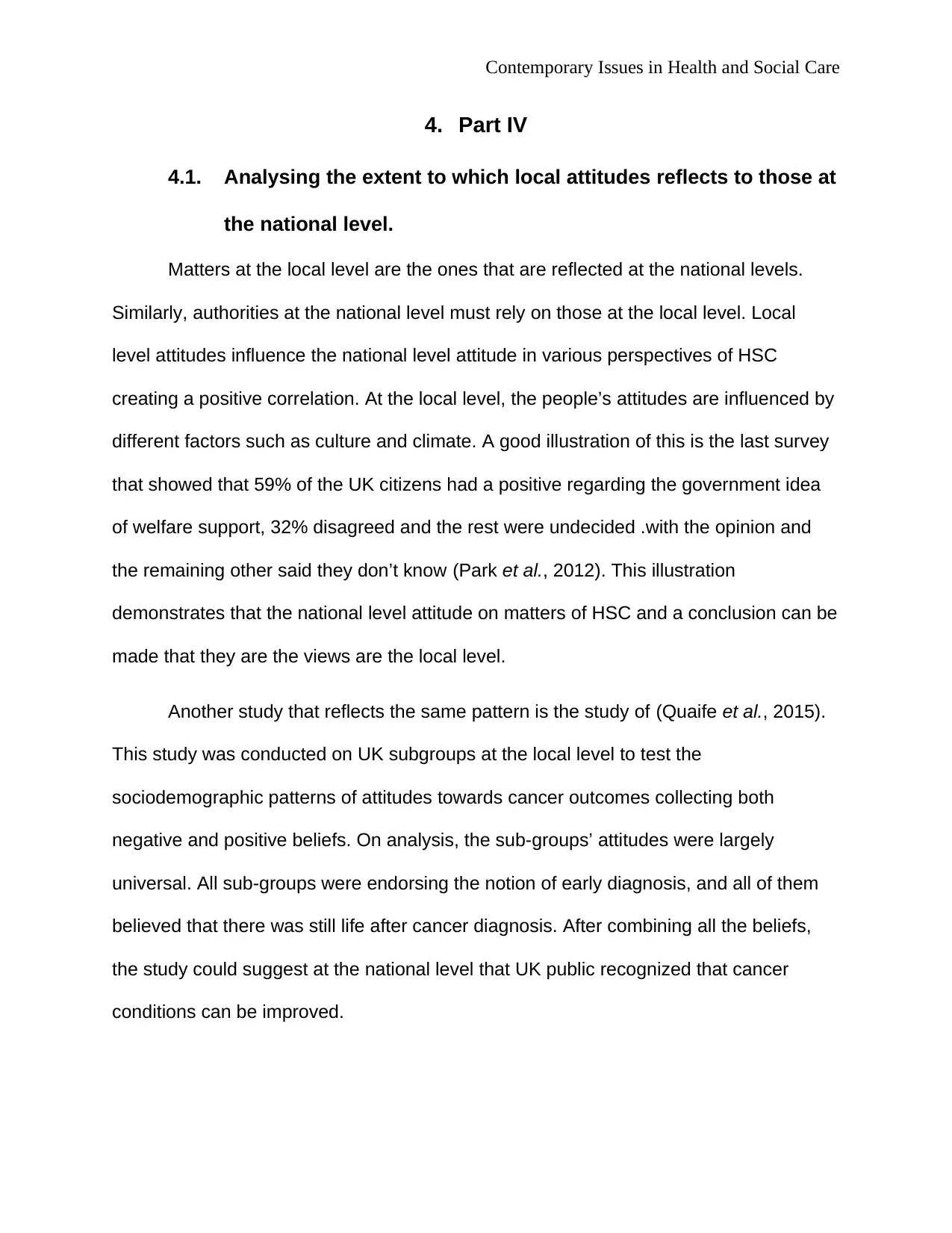
Contemporary Issues in Health and Social Care
4. Part IV
4.1. Analysing the extent to which local attitudes reflects to those at
the national level.
Matters at the local level are the ones that are reflected at the national levels.
Similarly, authorities at the national level must rely on those at the local level. Local
level attitudes influence the national level attitude in various perspectives of HSC
creating a positive correlation. At the local level, the people’s attitudes are influenced by
different factors such as culture and climate. A good illustration of this is the last survey
that showed that 59% of the UK citizens had a positive regarding the government idea
of welfare support, 32% disagreed and the rest were undecided .with the opinion and
the remaining other said they don’t know (Park et al., 2012). This illustration
demonstrates that the national level attitude on matters of HSC and a conclusion can be
made that they are the views are the local level.
Another study that reflects the same pattern is the study of (Quaife et al., 2015).
This study was conducted on UK subgroups at the local level to test the
sociodemographic patterns of attitudes towards cancer outcomes collecting both
negative and positive beliefs. On analysis, the sub-groups’ attitudes were largely
universal. All sub-groups were endorsing the notion of early diagnosis, and all of them
believed that there was still life after cancer diagnosis. After combining all the beliefs,
the study could suggest at the national level that UK public recognized that cancer
conditions can be improved.
4. Part IV
4.1. Analysing the extent to which local attitudes reflects to those at
the national level.
Matters at the local level are the ones that are reflected at the national levels.
Similarly, authorities at the national level must rely on those at the local level. Local
level attitudes influence the national level attitude in various perspectives of HSC
creating a positive correlation. At the local level, the people’s attitudes are influenced by
different factors such as culture and climate. A good illustration of this is the last survey
that showed that 59% of the UK citizens had a positive regarding the government idea
of welfare support, 32% disagreed and the rest were undecided .with the opinion and
the remaining other said they don’t know (Park et al., 2012). This illustration
demonstrates that the national level attitude on matters of HSC and a conclusion can be
made that they are the views are the local level.
Another study that reflects the same pattern is the study of (Quaife et al., 2015).
This study was conducted on UK subgroups at the local level to test the
sociodemographic patterns of attitudes towards cancer outcomes collecting both
negative and positive beliefs. On analysis, the sub-groups’ attitudes were largely
universal. All sub-groups were endorsing the notion of early diagnosis, and all of them
believed that there was still life after cancer diagnosis. After combining all the beliefs,
the study could suggest at the national level that UK public recognized that cancer
conditions can be improved.

Contemporary Issues in Health and Social Care
4.2. Evaluating the validity of public attitudes and behaviors in
relation to a specific issue
The National Awareness and Early Diagnosis Initiative (NAEDI) has various
approaches that enable the distribution of strategies for reforms on cancer awareness.
Among their strategy includes measures of evaluating and validating the public
awareness on various signs exhibited by the cancer disease. As a general conception,
media becomes one of the best places for collecting, evaluating and changing the public
views.
To some extent, the media has the capacity to reach more people becoming a
wide wide-reaching information base. Media also has the capacity to define and change
the way people think, and at the same time present a different opinion, attitude, beliefs
and behaviors of the public. However, the success of the media depends on the extent
of the transmission of the communication. For instance, by analyzing the Be Clear
Campaign (Hughes-Hallett et al., 2016), the campaign design was able to change the
public belief towards cancer signs. By use of the TV, the press, Radio, etc., the
campaign was able to reach a great number of people. And by using images of doctors
with messages stressing on their approachability, the campaign was changing any
negative perception of doctors from the public.
4.3. Justifying possible consequences of contemporary thinking for
HSC provision and services
Different people have diverse thoughts and belief regarding health. These
thoughts may be about wellness, eating behaviors, disease models etc. There are some
contemporary thinking that can have bad effects on health. For instance, there are
4.2. Evaluating the validity of public attitudes and behaviors in
relation to a specific issue
The National Awareness and Early Diagnosis Initiative (NAEDI) has various
approaches that enable the distribution of strategies for reforms on cancer awareness.
Among their strategy includes measures of evaluating and validating the public
awareness on various signs exhibited by the cancer disease. As a general conception,
media becomes one of the best places for collecting, evaluating and changing the public
views.
To some extent, the media has the capacity to reach more people becoming a
wide wide-reaching information base. Media also has the capacity to define and change
the way people think, and at the same time present a different opinion, attitude, beliefs
and behaviors of the public. However, the success of the media depends on the extent
of the transmission of the communication. For instance, by analyzing the Be Clear
Campaign (Hughes-Hallett et al., 2016), the campaign design was able to change the
public belief towards cancer signs. By use of the TV, the press, Radio, etc., the
campaign was able to reach a great number of people. And by using images of doctors
with messages stressing on their approachability, the campaign was changing any
negative perception of doctors from the public.
4.3. Justifying possible consequences of contemporary thinking for
HSC provision and services
Different people have diverse thoughts and belief regarding health. These
thoughts may be about wellness, eating behaviors, disease models etc. There are some
contemporary thinking that can have bad effects on health. For instance, there are
⊘ This is a preview!⊘
Do you want full access?
Subscribe today to unlock all pages.

Trusted by 1+ million students worldwide
1 out of 19
Related Documents
Your All-in-One AI-Powered Toolkit for Academic Success.
+13062052269
info@desklib.com
Available 24*7 on WhatsApp / Email
![[object Object]](/_next/static/media/star-bottom.7253800d.svg)
Unlock your academic potential
Copyright © 2020–2025 A2Z Services. All Rights Reserved. Developed and managed by ZUCOL.





